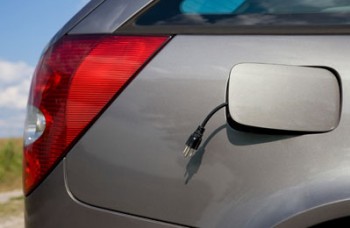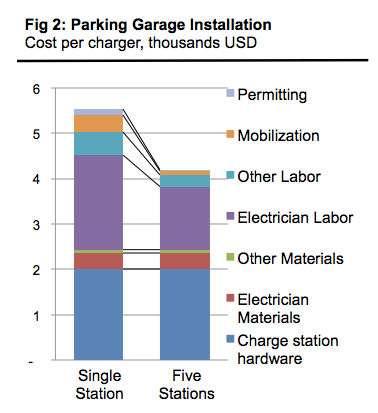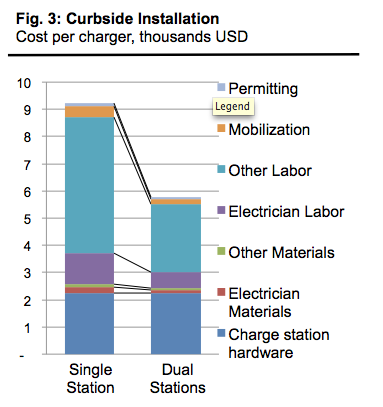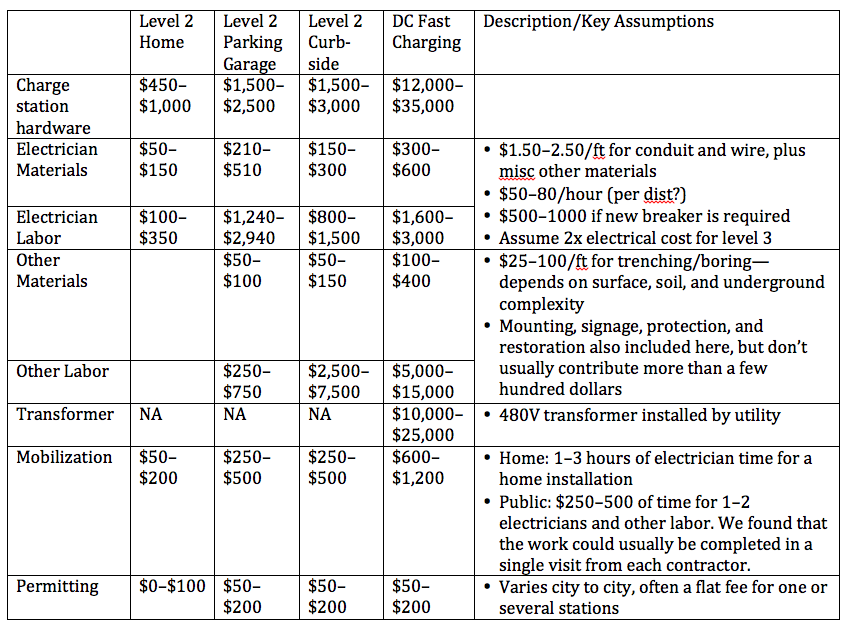
Pulling Back the Veil on EV Charging Station Costs
Guest author Ben Holland is an RMI alum.
Electric vehicles seem to have finally gained a solid foothold. With continued adoption, there will be an increasing need for access to charging locations. We recognize that many drivers today do most of their charging at home, but many others still require access to a robust nationwide charging station network before even considering the purchase of an electric vehicle. But high costs of equipment and installation are currently impeding the build-out of such a network. Therefore, cost-effective solutions are needed to ensure future investment in charging stations.
We recently interviewed over a dozen companies involved with charging station infrastructure—including utilities, automakers, cities, research institutions, and charging station companies—to pull back the veil on current EV charging station infrastructure costs. From there, the next post in this series can then explore charging station business models and strategies to reduce those per-station costs.
We’ve broken down the cost into several categories: 1) the actual charging station hardware, 2) other hardware and materials, 3) electrician and other labor, 4) mobilization, which we define as time for the electrician and others to prep and get to the worksite (often including an initial on-site consultation), and 5) permitting.
This is a look at raw infrastructure costs. We did not include: a) general and administrative overhead, which can easily contribute 20 percent or more to costs but which also reduce rapidly with experience, b) other miscellaneous costs, such as wage requirements for federally funded projects, which can add 15–25 percent to costs, and c) financing (and other costs of capital/debt) for charging station owners.
Similarly, we don’t include federal, state, and local EV charging station incentives that could reduce per-charging-station infrastructure costs, such as the federal EV charging station infrastructure tax credit that expired at the end of 2013, Connecticut’s EV charging station grant program, and the plug-in EV charger rebate program with the city of Anaheim, CA.
AT-HOME CHARGERS
When charging at home, many EV owners are content to charge overnight plugging into their regular home 120V outlet using level 1 equipment that is included with the vehicle. However, for those who desire level 2 speed or other features, a typical installation will cost a little over $1,000 (Figure 1). Over half of that cost is the charge station itself. Manufacturers are now offering level 2 home chargers for as low as $450, down from well over $1,000 in the early days. More expensive stations offer additional features like charge management, smartphone compatibility, or even grid integration.
Installation by an electrician—installing a 240V circuit from an existing breaker panel and making the connection to the station—accounts for most of the remaining cost, including materials, labor, and mobilization. A new breaker panel isn’t usually required, but in some older homes or if the existing panel is full will add approximately $500.
PUBLIC AC CHARGERS
Public stations are more expensive than home chargers and costs vary over a larger range depending on the type of installation, number of stations, and site specifics.
Single-port charging station hardware usually costs about $2,300, but can be as high as $6,000 for some features and brands. Public stations are heftier and often pedestal mounted. Extra features include LCD screens, advanced payment and data tracking communication, and dual-port power routing capabilities.
Unlike home stations, where hardware is the dominant cost, installation is the major contributor to public station cost (60–80 percent of total). Distance to the breaker box is usually the most important factor for determining installation cost, typically ranging from 50 to 100 feet. Runs longer than 150 feet are usually too expensive to justify station installation.
Parking garage installations are the easiest and most economical public charging stations and typically cost about $6,000 (Figure 2). Conduit and wiring can be wall mounted. Curbside and surface lot stations tend to be much more expensive than parking garage installations (Figure 3) because they frequently require costly ($25–$100/ft) trenching or directional boring to run conduit and wire to the station.
Installing a multi-port station, or multiple stations at once, reduces the cost per charger (second column of Figures 2 and 3), but demand must exist to justify the extra capacity. Cost is reduced mainly because a single trench/bore, conduit, and wire can be used to service the adjacent stations. Multiple stations are more likely to require a breaker box upgrade, and the feeder wire that is run from the box to the stations will be slightly more expensive, but the added cost can be divided across the extra stations. There are other efficiencies in mobilization, repetition, permitting, etc.
PUBLIC DC FAST CHARGERS
Level 3 stations allow much faster charging and many in the industry suspect they will eventually overtake Level 2 as the predominant method. However, their current cost is an order of magnitude higher than a Level 2 charger (Figure 4), costing $50,000–100,000 per station.
There are two main contributors to their high cost: 1) expensive equipment and 2) frequently the need to install a 480V transformer. Level 3 station hardware can be an order of magnitude higher than Level 2, although Nissan has recently designed a station with slightly lower capacity for about $13,000. Transformer cost adds $10,000–20,000, but with some searching locations that don’t require a transformer can sometimes be found. Electrician and other labor and material costs for level 3 chargers are only slightly higher relative to other increases.
Permitting, mobilization, and project overhead can also be much higher for a level 3 station—40 hours of time or an additional $10,000 would not be unusual. In one case, getting approval required attendance to a city planning commission meeting plus additional conversations with the city fire chief.
NETWORK AND OPERATING COSTS
Data and payment communications and capabilities can also have a significant impact on cost. Some packages are subscription-based and cost about $250 a year. For instance, ChargePoint offers a service plan that allows station hosts to set pricing, monitor usage, and enable drivers to locate and reserve stations online or through a mobile app. These costs vary depending on the intelligence of the station and the desired business model of the host or operator. There are valid arguments for and against installing stations with networking intelligence, which we’ll explore in future posts.
We didn’t include maintenance costs in our analysis, but studies suggest about $300 for a public Level 2 station and $1,000–2,000 for a Level 3 station.
In the next installment of this series, we’ll take a look at strategies and business models that can help to reduce these per-station infrastructure costs, thus making it more economically viable to realize a nationwide network of public EV charging stations.




